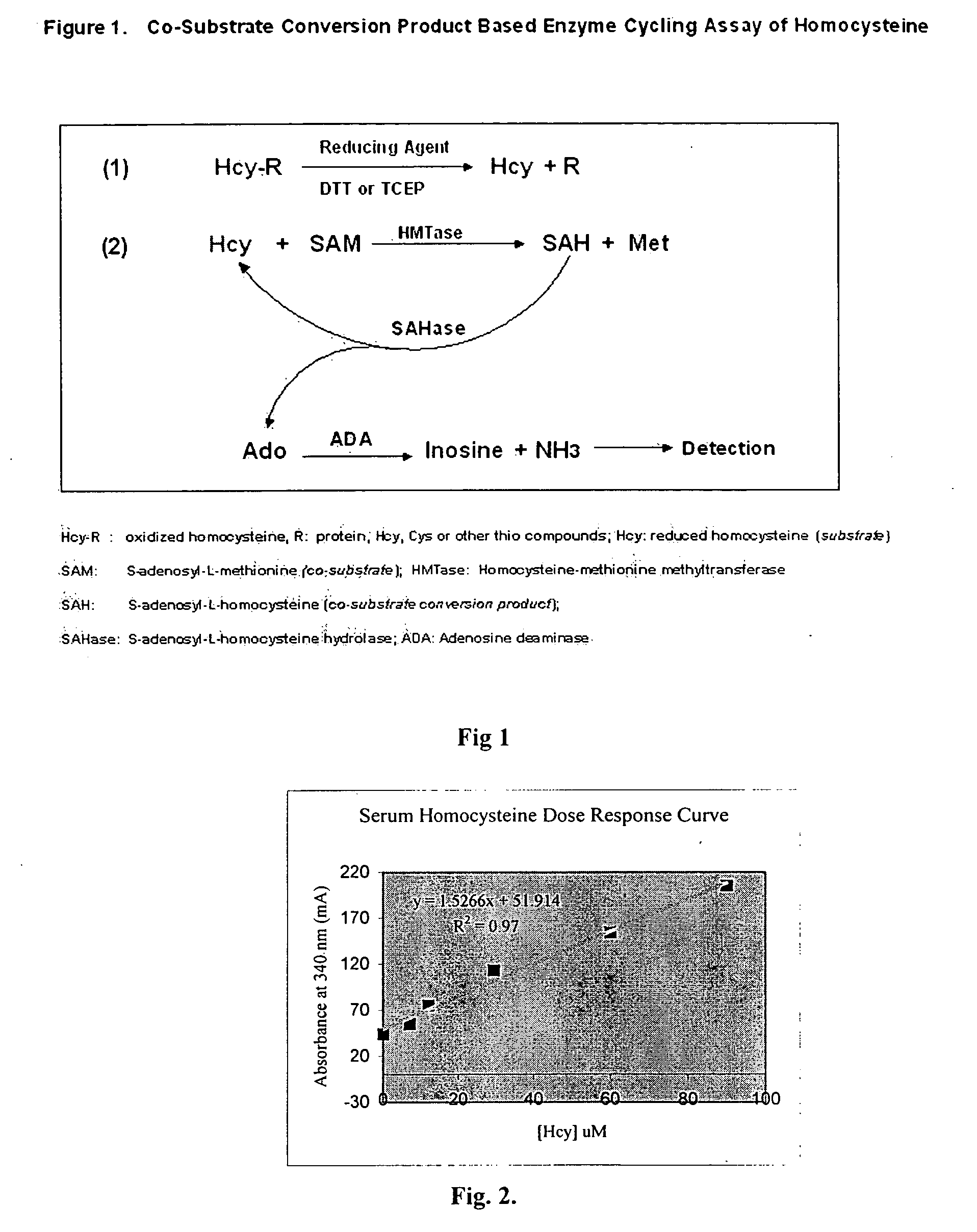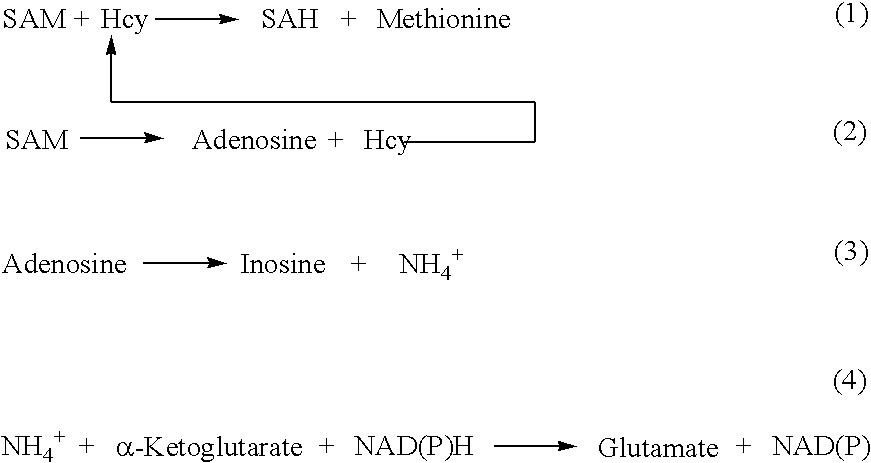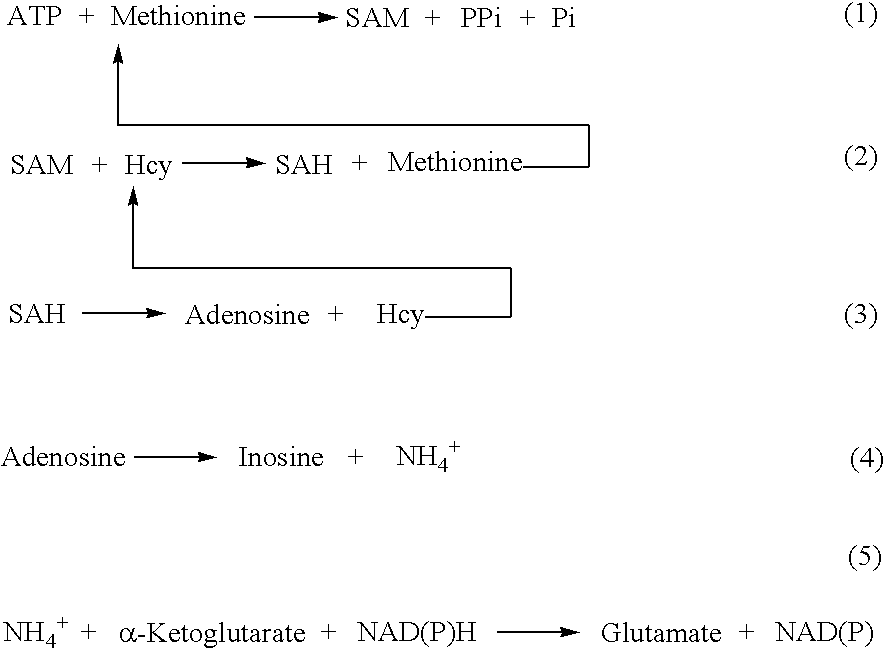Methods and compositions for assaying homocysteine
a technology of homocysteine and composition, applied in the field of homocysteine detection, can solve the problems of chromatographic separation, time-consuming and cumbersome, and myocardial infarction,
- Summary
- Abstract
- Description
- Claims
- Application Information
AI Technical Summary
Problems solved by technology
Method used
Image
Examples
example 1
GLDH-NADH Coupling to Detect NH4+ Generated by the Enzymatic Cycling Using Purified SAM
[0092] In this study, the following coupled enzymatic cycling reactions are used:
[0093] In scheme (1), the reaction is catalyzed by a SAM-dependent homocysteine S-methyltransferase. In scheme (2), the reaction is catalyzed by a SAH hydrolase. In scheme (3), the reaction is catalyzed by an adenosine deaminase. In scheme (4), the reaction is catalyzed by a L-glutamate dehydrogenase. The NAD(P)+ is spectraphotometrically detected at 340 nm. A more deteiled descirption of the reagents used in this study is set forth in the following Tables 1 and 2.
TABLE 1Compositions of Reagent 1ChemicalReagent 1ConcentrationPotassium phosphate15mMNAD(P)H5mMGLDH2KU / LBSA1.2g / LAdenosine Deaminase50KU / LHomocysteine methyltransferase10KU / LDTT0.2mMα-ketoglutarate30mMSAM3mM
[0094]
TABLE 2Compositions of Reagent 2ChemicalsReagent 2ConcentrationTris-HCl15mMBSA1.2g / LSAH hydrolase10KU / L
[0095] In this study, 180 μl of reagent...
example 2
GLDH-NADH Coupling to Detect NH4+ Generated by the Enzymatic Cycling Using SAM Concurrently Converted by SAM Synthase from ATP and Methionine
[0096] In this study, the following coupled enzymatic cycling reactions are used:
[0097] In scheme (1), the reaction is catalyzed by a SAM Synthase. In scheme (2), the reaction is catalyzed by a SAM-dependent homocysteine S-methyltransferase. In scheme (3), the reaction is catalyzed by a SAH hydrolase. In scheme (4), the reaction is catalyzed by an adenosine deaminase. In scheme (5), the reaction is catalyzed by a L-glutamate dehydrogenase. The NAD(P)+ is spectraphotometrically detected at 340 nm. A more deteiled descirption of the reagents used in this study is set forth in the following Tables 3 and 4.
TABLE 3Compositions of Reagent 3ChemicalReagent 3ConcentrationGood's buffer15mMNAD(P)H5mMGLDH2KU / LBSA1.2g / LTCEP0.2mMα-ketoglutarate30mMATP10mMMethionine5mMSAM Synthase10KU / LAdenosine Deaminase50KU / LHomocysteine methyltransferase20KU / LZnCl210...
example 3
Adenosine Kinase—Pyruvate Kinase—Lactate Dehydrogenase—NADH Coupling to Detect Adenosine Generated by the Enzymatic Cycling
[0100] In this study, the following coupled enzymatic cycling reactions are used:
[0101] In scheme (1), the reaction is catalyzed by a SAM-dependent homocysteine S-methyltransferase. In scheme (2), the reaction is catalyzed by a SAH hydrolase. In scheme (3), the reaction is catalyzed by an adenosine kinase. In scheme (4), the reaction is catalyzed by a pyruvate kinase. In scheme (5), the reaction is catalyzed by a lactate dehydrogenase. The NAD(P)+ is spectraphotometrically detected at 340 nm. A more deteiled description of the reagents used in this study is set forth in the following Tables 5 and 6.
TABLE 5Compositions of Reagent 5ChemicalReagent 5ConcentrationPotassium phosphate15mMNADH5mMGLDH2KU / LBSA1.2g / LAdenosine Kinase10KU / LHomocysteine methyltransferase10KU / LDTT0.2mMMgCl215mMPyruvate Kinase5KU / LLactate Dehydrogenase25KU / LSAM3mM
[0102]
TABLE 6Compositions...
PUM
| Property | Measurement | Unit |
|---|---|---|
| concentration | aaaaa | aaaaa |
| HPLC | aaaaa | aaaaa |
| capillary gas chromatography | aaaaa | aaaaa |
Abstract
Description
Claims
Application Information
 Login to View More
Login to View More - R&D
- Intellectual Property
- Life Sciences
- Materials
- Tech Scout
- Unparalleled Data Quality
- Higher Quality Content
- 60% Fewer Hallucinations
Browse by: Latest US Patents, China's latest patents, Technical Efficacy Thesaurus, Application Domain, Technology Topic, Popular Technical Reports.
© 2025 PatSnap. All rights reserved.Legal|Privacy policy|Modern Slavery Act Transparency Statement|Sitemap|About US| Contact US: help@patsnap.com



